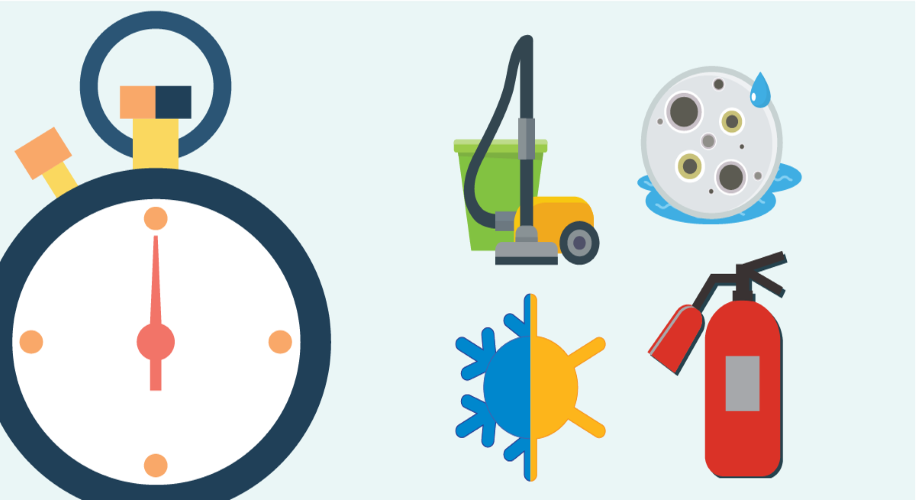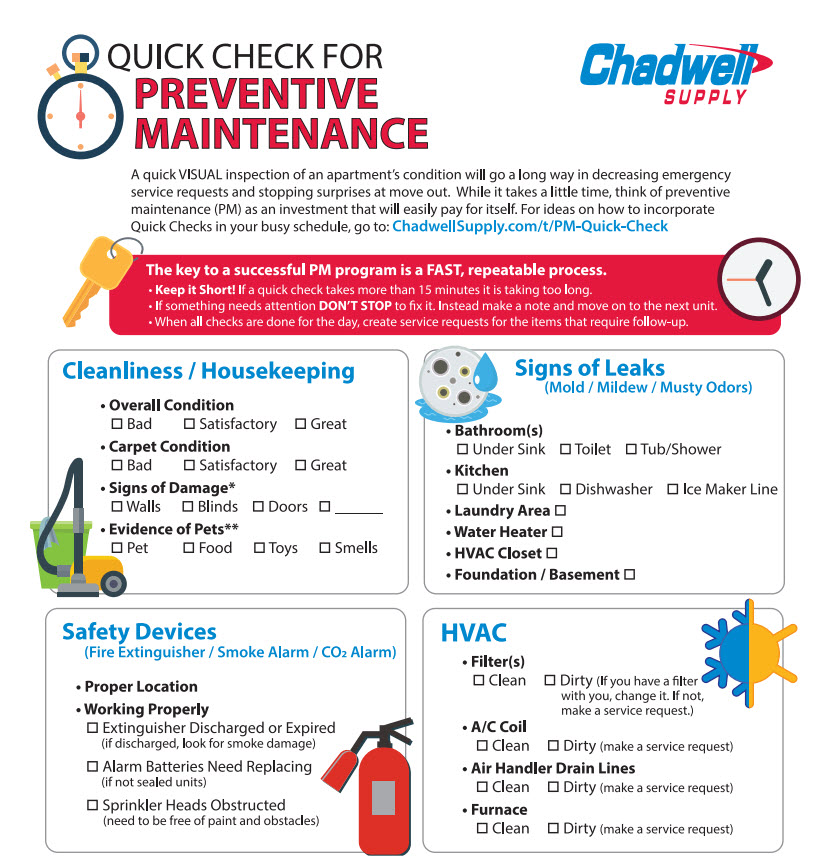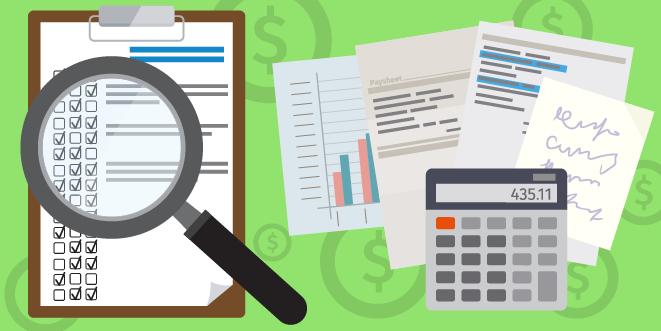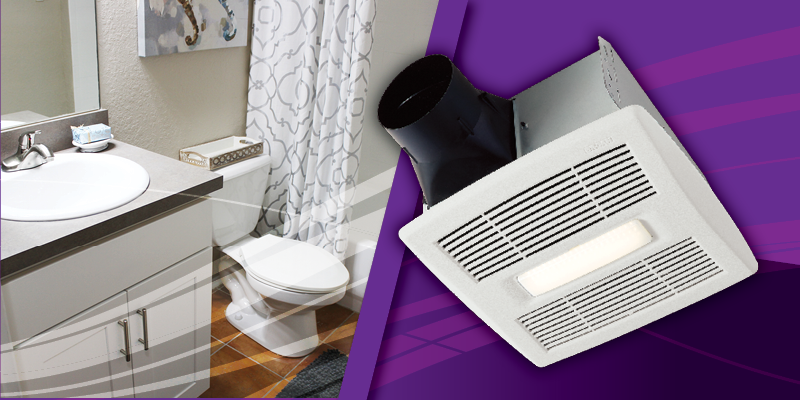Preventive Maintenance Quick Check
Here's a Quick Check Guide for Creating a Preventive Maintenance Program for Your Property.
The key to a successful PM Program is a fast, repeatable process.
In the words of Benjamin Franklin, “An ounce of prevention is worth a pound of cure.” However, translated into the multifamily industry it might be better said: “a few minutes of preventive maintenance means fewer emergency service requests.”
Preventive maintenance, or PM in the multifamily industry, may not be a popular topic with staff, but a quick visual inspection of an apartment’s condition and systems will go a long way in curbing emergency service requests and avoiding surprises at move out. So it’s time to start changing any negative thoughts and begin to think of PM an investment that will easily pay for itself.
The key to a successful PM program is a FAST, repeatable process. Keep it short! If it takes more than 15 minutes per unit, it is too long—you are getting stuck on minor details. If something needs attention DON’T STOP to investigate it or fix it. Instead, make a note and move on to the next unit. Then, when all planned checks are done for the day, create service requests for the items that require follow-up.
To help keep on task, here are four areas to focus on:
Cleanliness / Housekeeping
- Overall Condition - Rating the overall condition of a unit helps give an indication of what can be expected to move out. A unit that is kept clean and in good condition will likely have fewer problems when the lease expires. However, if the overall condition is bad, it could quickly escalate to other issues, such as pests, and concerns may need to be addressed sooner rather than later.
- Carpet Condition - Noting the condition of the carpet is another way to keep on top of potential issues (and plan from a budgetary perspective) to help avoid surprises at move out.
- Signs of Damage - When damage is found it’s time to document! If there are items that need to be repaired, then make arrangements to do so, and collect on damages while the resident lives there, instead of trying to recover charges after the fact. While leaving items like blinds or screens broken or torn may seem easier, it can impact curb appeal and the impression that the property is not well maintained.
- Evidence of Pets - Many times maintenance personnel are the first to be alerted to a pet living in the apartment. This is all fine and good if the resident has paid the deposit, but if they are hoping to sneak by without ever mentioning that they recently acquired an animal, PM checks can actually be a revenue generator. When residents know you will be coming, unauthorized furry friends often disappear for a day. However, there are many things residents forget: food or food bowls, pet toys or leashes, litter boxes, and the smells. If the pet (or evidence of a pet) is found, then make a note and follow up to make sure the appropriate documentation and deposits exist.
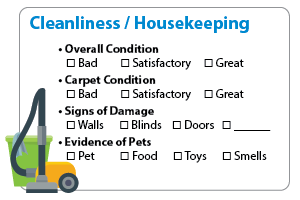
Signs of Leaks
Water intrusion can take on many forms and cause major damage when not dealt with quickly. Mold, mildew or even musty odors are indicators that moisture is a problem. There are several key areas to check for signs of water where it should not be:
- Bathroom(s) - Beyond looking for apparent leaks, check for areas were moisture may be clinging to surfaces and causing an issue. For example, if there are signs of mildew in the tub/shower it may be a good idea to remind the resident to turn on the bathroom fan after taking a shower to help dry out the room.
- Kitchen – wet spots or warped cabinets are a clear indication of an issue. Also, don’t forget if there is an icemaker on the refrigerator, then a quick visual check is warranted on the floor or baseboards near the fridge as well.
- Laundry Area – look at the floor for signs of water and check out the hoses to make sure they are in good condition.
- Water Heater – are there signs of discharge on the floor from the T&P valve or indications of a leak beyond any moisture caused by condensation (rare) then further water heater troubleshooting is warranted and a service request should be created.
- HVAC Closet – check for wet drywall, trim or other indications of water intrusion from an overflow pan or a blocked drain line.
- Foundation / Basement – if the property/unit has a basement, then check it. Make sure there are no signs of moisture or water intrusion.
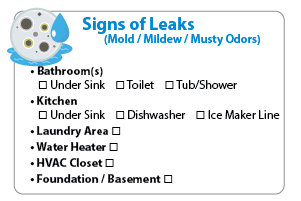
Safety Devices
It’s not just about just having fire extinguishers, smoke alarms and CO2 alarms in the proper place (although that needs to be checked too). A PM check should also make sure that these devices will function properly if needed.
- Fire Extinguishers – check the extinguisher’s status, make sure it has not expired (and will not expire before the next PM check) also make sure it has not been discharged. If it has, then take a closer look for any signs of smoke damage.
- Smoke and Co2 Alarms - Do batteries in smoke alarms (if not sealed units) need to be changed? Changing batteries is recommended every 6 months. Check the installation date (hopefully written on the outside of the unit) and make sure it is still within its 10-year life span (both for 9V and sealed devices). Make sure the alarm is in working order (i.e. not hanging off the ceiling or covered in saran wrap).
- Fire Suppression Systems - If the building is equipped with sprinkler heads, double check that they are free from paint and not obstructed.

HVAC
Heating and air conditioning problems are among the leading causes of service requests. As a result, keeping up on PM makes a huge difference. The easiest thing to do during a PM check is to bring a box of filters with you (if your complex supplies them) and switch out filters as needed. If you are doing a PM check and don’t happen to have a filter with you and it needs to be changed, don’t take the time to go get one, just note it and create a service request for a future time. Likewise for checking the A/C Coil, Air Handler Drain Lines, and the Furnace, if there are any items for concern then make a note to create a separate service request.
In addition to the quick visual inspection during a PM check, make sure to schedule dedicated time to perform routine preventive maintenance on the HVAC units so that they will work reliably for residents and decrease the number of service emergencies arising from these systems.
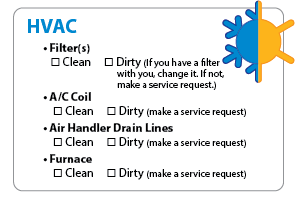
Scheduling PM Checks
So how do you incorporate PM checks into your already overflowing maintenance schedule and make it efficient for all involved? A half-hour a day? A half-day a week? Every Wednesday afternoon at 2:00? There isn’t one right answer, the only wrong answer is not scheduling it at all. So, here are some ideas:
- Get buy-in from the whole team, from leasing to maintenance and everyone in between. At any time a team member enters an occupied apartment, train them to look beyond the reason they were called in. Teach them to perform a quick survey of what is going on from a preventive maintenance perspective and report any concerns (or pets) in a timely manner.
- Avoid setting large blocks of time aside, such as a week in each season, because inevitably something happens during that time and the PM check gets pushed out to another time. Instead, work PM into the daily schedule by checking 2-4 units a day (30 min-1 hr. total). This way the team isn’t overwhelmed trying to get through a huge number of checks in a short time frame, plus other emergencies that will inevitably come up.
- Pick a building per month and focus on PM checks in that building. The following month, move to the next building. This system will keep all units on a rotating PM schedule without feeling the pressure of doing the whole complex at once.
- If you have to escort service providers (i.e. pest control) through units then make good use of your time and take a PM checklist and do a quick check while waiting on the provider. If you happen to take filters and change them out while escorting the service provider, then you get extra bonus points!
- Don’t be afraid to get creative and make use of your team’s time. If ownership requires a visual inspection of each unit, then grab the PM checklist and do the two together. More bonus points if you tie PM checks to budget prep or updating the capital needs inventory for the property.
- Create a simple record-keeping system to track what units have been checked and, when you come back around to the beginning of your rotation, refer to notes of the last check to identify potential on-going, recurring, or worsening issues in a particular unit.
The Result? Fewer Emergencies.
Taking the time to survey and check units on a routine basis means better upkeep and fewer surprises. Of course, emergencies will still happen, but they will begin to happen less frequently and when they do, they will hopefully not be catastrophic failures—a win for all involved.
We’d love to hear your stories of a successful PM program, feel free to email us or download this handy PM Quick Check worksheet.


